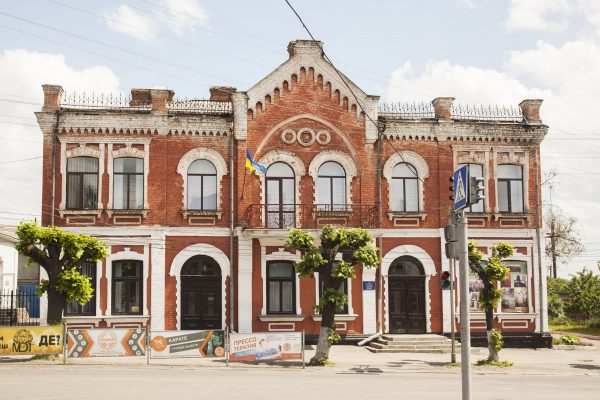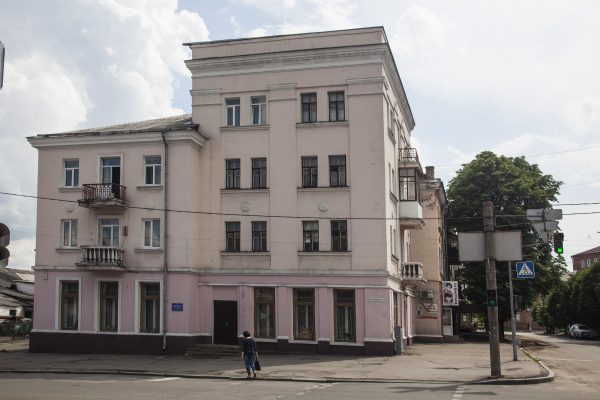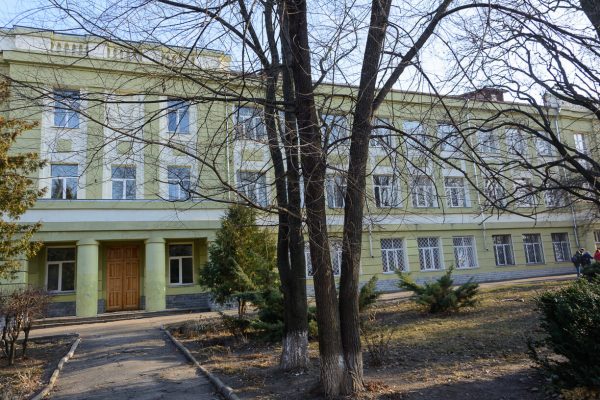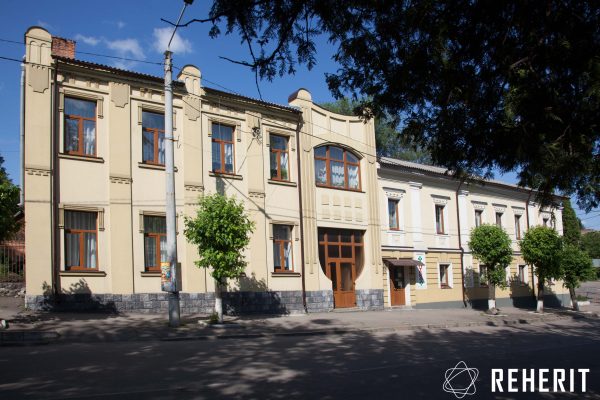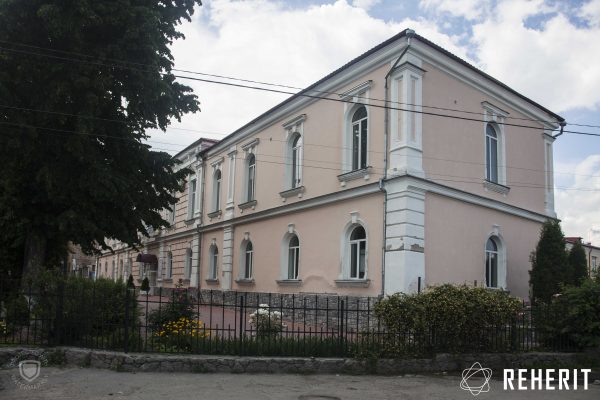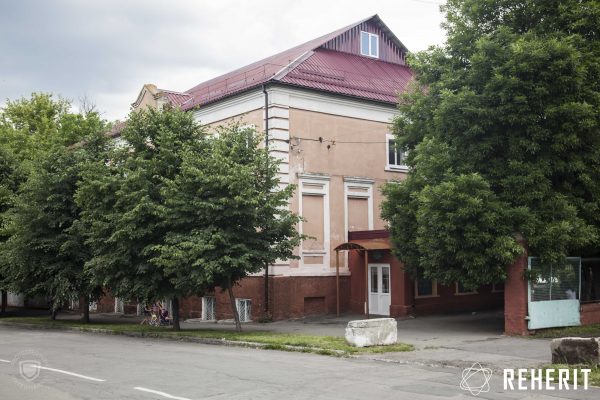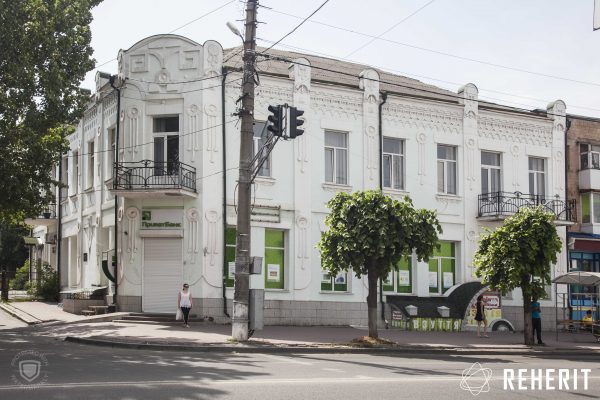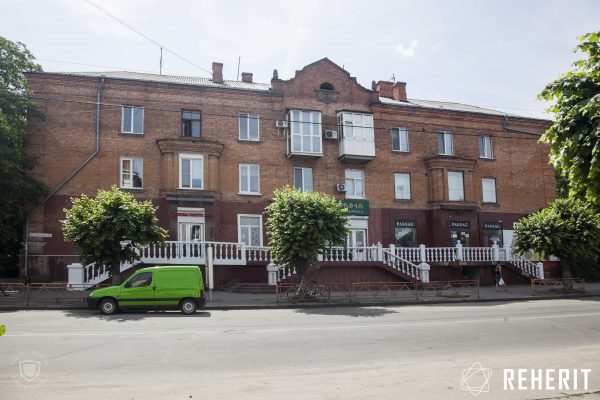English below ↓
Монастир Покрови Пресвятої Богородиці був заснований в Умані у 1765 р. за сприяння воєводи Київського Францішека Салезія Потоцького. Монастир отримав від Потоцького щедру фінансову підтримку: двісті тисяч злотих на потреби обителі та два села – Гереженівка та Монастирок, прибутки з яких йшли на її утримання. Магнат також подарував монастирю площу в Умані, на якій розташували церкву, школу та келії для монахів. Стати першим ігуменом монастиря був запрошений о. Іраклій Костецький, випускник папської семінарії у Вільно, знаний проповідник та активний місіонер. Спочатку усі будівлі монастиря були дерев’яними.
Історія василіянського монастиря в Умані – від заснування до закриття – показує, якими непростими були міжконфесійні стосунки у прикордонних багатоетнічних регіонах, де конфесії змагалися за контроль над одним простором, і наскільки тісно релігійне життя було переплетене із питаннями політичної влади. У XVIII ст., коли Правобережжя повернулося під владу Речі Посполитої, серед найгостріших тут постав конфлікт між церквами католицькою та греко-католицькою, з одного боку, та православною, з іншого. Особливої гостроти цей конфлікт набував тому, що питання віри було не лише справою порятунку душі, воно визначало етнічну ідентифікацію, політичну лояльність та геополітичну орієнтацію. Католицизм сприймався як синонім польськості та відданості Речі Посполитій, натомість православ’я ототожнювали із нижчими соціальними прошарками та орієнтацією на підтримку від Російської імперії. Перемога ж у цьому затятому конфлікті найчастіше була на боці того, кого підтримувала влада.
Греко-католицькій церкві у суперечці конфесій випала непроста роль. Створена заради примирення вірян у Речі Посполитій та компромісу між східним та західним християнством, вона подеколи сприймалася польською владою та елітою як інструмент поширення католицизму серед православного населення, своєрідний місток до суто католицького світу. У XVIII ст. греко-католицька церква за активної підтримки держави та місцевих магнатів, які не цуралися і силового тиску, опанувала території, де раніше переважало православ’я. Одним з осередків поширення греко-католицької та католицької віри в регіоні став і відкритий в Умані василіянський монастир.
Чин св. Василія Великого є найвідомішим уніатським чернечим орденом. Він був створений за зразком католицьких чернечих орденів, зокрема єзуїтського, для оновлення і піднесення греко-католицької церкви. Василіяни уславилися чудовими школами, бо розуміли виняткову важливість освіти як для успішної роботи священників, так і для виховання молоді. Блискуче освічені і готові до взаємодії зі спільнотами, серед яких жили, василіяни також були вправними проповідниками і місіонерами. Вже з 1766 р. при уманському василіянському монастирі стали діяти теологічні студії для ченців та колегіум для молоді. За даними історика Ігоря Кривошеї, на момент заснування монастиря в Умані передбачалося, що тут житимуть 4 місіонери, 4 чи більше професорів (залежно від кількості учнів в училищі), вікарій, настоятель, духовники та проповідники, необхідні для священнослужіння.
За кількістю монахів василіянський монастир в Умані належав до середніх. Тут мешкали зазвичай від 12 до 16 ченців, тоді як великими вважали василіянські монастирі, де кількість монахів перевищувала 20 осіб – такі як у Почаєві чи Замості. Побут ченців регламентував спільний для усіх василіянських монастирів устав, розроблений в 1617 р. Він передбачав обітниці убозтва (зокрема відмову від грошей, заборону пишного одягу і дорогих страв), чистоти (приборкання плоті та зречення усього, що плямує душу людини), послуху (передусім перед настоятелем) та спільне життя чернечої спільноти.
Перші роки існування василіянського монастиря в Умані співпали із черговим загостренням стосунків між католиками, уніатами та православними, зенітом якого стала діяльність Барської конфедерації 1768 р. – насильство проти православних у Київському воєводстві, що супроводжувалося закриттям православних церков, знущанням над православними священниками і суворими карами громад, що намагалися чинити спротив. Це посилило серед міщан, селян та козацтва упередження щодо усіх греко-католицьких священників як “відступників від істинної віри” та “поплічників польських панів та ксьондзів”. Під час Коліївщини 1768 р. в Умані монастир став однією з мішеней нападу гайдамаків.
Українці старшого і середнього віку, які в школі обов’язково за програмою читали поему Тараса Шевченка “Гайдамаки”, переважно уявляють собі долю монастиря і колегіуму за літературним описом:
... Гайдамаки
Стіни розвалили –
Розвалили, об каміння
Ксьондзів розбивали,
А школярів у криниці
Живих поховали.
Сьогодні частина істориків критично сприймає поширену легенду про загибель учнів у криниці. Через чутки про наближення повстанців для 400 учнів колегіуму були оголошені дочасні канікули, тому більше половини з них встигли виїхати з міста. Водночас більше ста учнів (юнаки у віці від 16 років) залишилися, більшість з них отримала зброю і билася на боці польських загонів при захисті міста. Вони загинули в боях та на вулицях міста, де ставали жертвами гайдамаків як поляки та як молоді шляхтичі. Знаючи про загрозу облоги, ігумен дозволив монахам василіянського монастиря рятуватися, і частина з них змогла покинути Умань. Ті, хто вирішив залишитися в обителі, прийняли мученицьку смерть від рук гайдамаків. Дослідники історії василіянського чину наголошують на важливості згадувати імена загиблих, відтворити які дозволяють джерела. Це ігумен о. Іраклій Костецький, о. Іван Левицький, о. Ліберій Очавський, о. Ілля Магерович, Методій Маєвський.
Ця трагічна сторінка історії василіянського монастиря в Умані, як і взагалі історія жертв Коліївщини, у місцевій краєзнавчій традиції тривалий час оминалася як незручна, така, що не пасує оповіді про справедливий виступ скривджених національних героїв. З 2010-х років на подвір’ї колишнього василіянського монастиря стали проводити екуменічні панахиди за невинно убієнними жертвами Коліївщини. У 2018 р. Асоціація єврейських організацій і общин України (ВААД) та Українська греко-католицька церква виступили з ініціативою відкрити на території монастиря меморіал у вигляді живильного джерела, який вшановував би жертв Коліївщини – євреїв, католиків та греко-католиків – і наголошував би на скорботі та співчутті у пам’яті про події.
1770 - 1780 рр. стали для монастиря часом відбудови і відродження. Дерев’яні будівлі келій, храму та колегії були замінені на муровані. Розвивалася й освітня робота монастиря: колегіум при ньому остаточно перетворився на світський навчальний заклад. Наприкінці XVIII - початку ХІХ ст. до курсу дисциплін додали математичні (арифметика, алгебра, геометрія) та природничі (географія, фізика, хімія) науки, стали вивчати нові європейські мови, історію та право, учнів вчили малюванню та музиці.
Вже з 1790-х років завдяки навчальному закладу при монастирі Умань стала знаним регіональним центром освіти. Саме успішність і масштабність школи дозволили василіянському монастирю вижити і розвиватися в нових умовах, коли після другого поділу Польщі та переходу Правобережжя до складу Російської імперії уряд розпочав активну антикатолицьку та антиунійну кампанію.
Школа при монастирі сповідувала принцип “навчати всіх, якої б віри не були”. У 1801 р. тут було 263 учні, у 1816 р. – 448. Хоча школа була відкрита для всіх станів та християнських конфесій, серед учнів переважали юнаки з польських шляхетських родин Брацлавщини (це сучасна Вінницька, частково Черкаська, Кіровоградська та Одеська області) та Південної Київщини, католики за віросповіданням, а польська мова домінувала як мова викладання.
У школі при василіянському монастирі в Умані вчилися майбутні відомі літератори, яких віднесуть до т. зв. “української школи” в польській літературі. Це троє юнаків Юзеф Богдан Залеський, Міхал Грабовський та Северин Гощинський. Під час студій у місцевому колегіумі у 1816 р. вони створили літературний гурток “За-Го-Гра”. Ця літературна школа стала своєрідним феноменом взаємодії польської та української культур: молоді вихідці з польських родин Поділля та Волині звернулися до сюжетів козацької та гайдамацької історії та вивчення українського фольклору. “Українська школа” зробила козаків та гайдамаків героями високої літератури. Письменникам романтичного напрямку, яких вабило передусім величне і страшне, екстремальний досвід людей і народів, годі було й шукати інших героїв. Ці поети намагалися також осмислити особливості українсько-польського співжиття та причини його конфліктності. Поема Северина Гощинського “Замок Канівський” (1828), що описує захоплення Канева гайдамаками, належить до найвідоміших літературних творів про Коліївщину і справила безсумнівний вплив на Тараса Шевченка та його поему “Гайдамаки” (1841). Твори “української школи” в польській літературі стали водночас джерелом і для натхнення, і для інтелектуальної протидії українського національного руху першої половини ХІХ ст. Адже для польських поетів козацька та гайдамацька історія була локальною історією одного з регіонів Речі Посполитої, а шляхетсько-козацькі конфлікти – прикрим розбратом підданих однієї держави.
Василіянський монастир був закритий російським урядом у 1831 р., після Листопадового польського повстання. Монастир було остаточно ліквідовано у 1834 р. А у 1839 р. діяльність греко-католицької церкви та її ордену на Правобережжі було заборонено, а її віряни (хто вмовлянням, а хто жорстким примусом) були долучені до православ’я. Активна антиунійна кампанія призвела і до дискредитації діяльності монастирів, забуття їхніх освітніх та культурних здобутків, зведення історії інституцій до відомих кліше про “ополячення” і “покатоличення”.
Спочатку будівлю монастиря використовували як в’язницю для підозрюваних в участі у повстанні. Згодом, коли Умань стала центром військових поселень, тут діяв військовий шпиталь, а з середини 1850-х до початку 1880-х років – казарми. До Першої світової війни у будівлі засідав окружний суд.
Велика кам’яна будівля в центрі Умані активно використовувалася владою і під час революцій 1917-1921 рр.: тут засідав Військово-революційний комітет більшовиків, діяв штаб Червоної гвардії.
Восени-взимку 1921 р. в будівлі монастиря ставив свої вистави Київський драматичний театр (“Кийдрамте”), очолюваний українським режисером та актором Лесем Курбасом. Хоча на перший погляд театр і монастир – це несумісні поняття, насправді йдеться про своєрідне продовження традиції. Театральна історія Умані бере свій початок саме від василіянського монастиря. Адже перші вистави в Умані представляли студенти колегіуму ще наприкінці XVIII ст. – на свята, під час ярмарків та до приїздів власника міста. Символічно, що серед п’єс, які ставив київський театр, поруч із “Макбетом” Вільяма Шекспіра та “Гріхом” Володимира Винниченка були і “Гайдамаки” Тараса Шевченка.
До Другої світової війни будівлю займало центральне бюро профспілок. З 1950-х тут знову облаштувалися військові, і військова частина базувалася до 1998 р. У незалежній Україні будівля перебувала в оренді у найрізноманітніших приватних установ. Зокрема кілька років тут діяв нічний клуб із колоритною назвою “Огненная лошадь”, відкриття якого дехто вважав блюзнірством.
З 2006 р. будівля василіянського монастиря стала частиною Державного історико-архітектурного заповідника “Стара Умань”. Тут почали проводити екскурсії підземеллями монастиря – до теперішнього часу добре збереглися підземні переходи, господарські приміщення та келії монахів. Оскільки будівля – єдиний збережений до сьогодні в Умані сакральний об’єкт греко-католицької церкви, місцева греко-католицька громада веде перемовини з владою проможливість проведення тут богослужінь.
АВТОРКА ТЕКСТУ: Тетяна Портнова.
АРХІВНЕ ФОТО: Уманський краєзнавчий музей.
Василіянський монастир є одним з 10 об'єктів, ознакованих в Умані у ході реалізації проекту ReHerit. Об'єкти актуалізують теми, місця та імена спільної спадщини міста. Детальніше про маршрут та інші його об'єкти за посиланням.
Basilian Monastery
31, Nebesnoii Sotni St.
The Monastery of the Protection of Our Lady was founded in Uman in 1765, with the support of the Voivode of Kyiv, Franciszek Salezy Potocki. Potocki provided the monastery with generous financial support: two hundred thousand zlotys, as well two villages – Herezhenivka and Monastyrok, the income from which also went to fulfill the cloister’s needs. The magnate also gave the monastery land in Uman, which was used to build a church, a school, and cells for the monks. Rev. Irakli Kostecki, a graduate of the Papal Seminary in Vilnius, a famous preacher and active missionary, was invited to the post of the monastery’s first hegumen. Initially all the buildings of the monastery were made of timber.
The history of the Basilian Monastery in Uman, from its founding to its closing, shows the fraught nature of interdenominational relations in multiethnic border regions, where various denominations and faiths jockeyed for control over the same space – and the close links between religious life and political power. In the 18th century, when Right-Bank Ukraine came back under the authority of the Polish-Lithuanian Commonwealth, one of the most pronounced conflicts here arose between the Roman Catholic and Greek Catholic Churches on the one hand, and the Orthodox Church on the other. This conflict was especially bitter because the question of religion was not only about saving souls; it also determined ethnic identity, political loyalty, and geopolitical orientation. Catholicism was seen as synonymous with Polishness and loyalty to the Commonwealth, whereas Orthodoxy was identified with the lower social estates, and expectation of support from the Russian Empire. Victory in this bitter struggle most often belonged to whoever the authorities supported.
The Greek Catholic (Uniate) Church had a difficult role to play in this interdenominational debate. Originally founded for the sake of reconciliation of the faithful in the Polish-Lithuanian Commonwealth, as a compromise between Eastern and Western Christianity, it was sometimes seen by the Polish authorities and elites as a tool of spreading Catholicism among the Orthodox population, a sort of bridge to the “purely” Catholic world. In the 18th century, with support from the state and the local magnates, who sometimes did not shy away from force, the Greek Catholic church conquered territories where Orthodoxy previously dominated. The newly opened Basilian Monastery in Uman, too, became one of the centers for spreading the Greek Catholic and Roman Catholic faith in the region.
The order of St. Basil the Great is the best known of the Uniate monastic orders. It was modeled after Catholic monastic orders, particularly the Jesuits, with the idea of renewing and elevating the Greek Catholic Church. The Basilians were famous for wonderful schools, because they understood the exceptional importance of education both for priestly work, and for raising youth. Well educated and ready to work with communities in which they lived, Basilians were also skilled preachers and missionaries. The Basilian Monastery in Uman opened theological studies for monks and a college for youths as early as 1766. According to historian Ihor Kryvosheia, at the moment the monastery was founded in Uman, it was assumed that it would be home to four missionaries, four or more professors (depending on the number of students in the school), a vicar, an abbot, confessors and preachers necessary for priestly work.
The Basilian monastery in Uman was medium-sized – usually home to 12-16 monks, in contrast to the big monasteries with 20 or more monks, like Pochaiv or Zamosc. The everyday life of the monks was regulated by the 1617 Statute, common for all Basilian monasteries. This included vows of poverty (a rejection of money, fine clothes and expensive foods), purity (chastity and a rejection of anything that defiles the soul), obedience (primarily to the abbot), and a shared life in the monastic community.
The early years of the Basilian monastery in Uman coincided with another wave of tensions between Catholics, Uniates and Orthodox, ultimately leading to the Bar Confederation of 1768 – oppression against the Orthodox in the Kyiv Voivodeship, accompanied by the closing down of Orthodox churches, abuse of Orthodox priests, and repression against communities trying to resist. Among the urban dwellers, the peasants, and the Cossacks, this strengthened the impression of Greek Catholic clergy as “apostates from the true faith,” and “henchmen of Polish magnates and Catholic priests.” During the Koliyivshchyna uprising of 1768, the monastery in Uman became one of the targets for the Haidamaks.
Middle-aged and older Ukrainians, for whom Taras Shevchenko’s poem “Haidamaky” was required reading in the curriculum, usually imagine the fate of the monastery and the college according to Shevchenko’s literary description:
“… the Haidamaki tore
The walls to pieces. ‘Gainst the stones
They bashed the heads of priests,
And the young pupils, still alive
They threw in cisterns deep.”
Some historians today take a critical view of the widespread legend about “the young pupils” and their death in the well (“in cisterns deep”). Rumours about the approach of the rebels caused the college to announce early recess for the college’s 400 students, which provided enough time for over half of them to leave the town. At the same time, over a hundred students (young men aged 16 and up) remained, most of them were given arms and fought on the side of the Polish detachments in the city’s defense. They died in combat and in Uman’s streets, where the Haidamaky killed them as Poles and as young noblemen. Aware of the threat of siege, the abbot allowed the monks of the Basilian monastery to save themselves, and some of them managed to leave Uman. Those, who decided to stay in the cloister, died as martyrs at the hands of the Haidamaks. Scholars who study the history of the Basilian order stress the need to remember the names of the fallen that can be found in the sources. Among these are Hegumen, Rev. Irakli Kostecki, Rev. Ivan Levytskyi, Rev. Liberii Ochavskyi, Rev. Illia Maherovych, and Metodii Mayevskyi.
For a long time the local historical tradition chose to avoid this tragic page in the history of the Basilian monastery, and the story of the victims of Koliyivshchyna, as uncomfortable, as something that didn’t fit that narrative of a just uprising of wronged national heroes. The 2010s saw the start of a new tradition: ecumenical memorial services for the innocent victims of Koliyivshchyna in the courtyard of the former Basilian monastery. In 2018 the Association of Jewish Organizations and Communities of Ukraine (VAAD) and the Ukrainian Greek Catholic Church came up with the initiative to inaugurate a memorial in the monastery’s ground; a well to commemorate the victims of Koliyivshchyna – Jews, Roman Catholics and Greek Catholics – and emphasize mourning and compassion in remembrance of those events.
1770 – 1780 were a period of reconstruction and revival for the monastery. The wooden buildings of the cells, the church and the college were replaced with stone structures. Educational work also grew: the monastery college became a fully secular learning institution. In the late 18th and early 19th century mathematics (arithmetic, algebra, geometry) and natural science (geography, physics, chemistry) were added to the curriculum. The school also began teaching modern European languages, history and law, as well as painting and music.
Thanks to its monastery school, by the 1790s Uman was a regionally known educational center. It was the success and size of the school that allowed the Basilian monastery to survive and thrive in new conditions, when, after the Second Partition of Poland and Right-Bank Ukraine’s accession to the Russian Empire, the government mounted a broad anti-Catholic and anti-Uniate campaign.
The monastery school followed the principle of “teaching everyone, of any faith.” In 1801 the school had 263 students, and by 1816 their number grew to 448. Although the school was open to all estates and Christian denominations, the majority of students were young men from Polish noble families of the Bratslav Voivodeship (today’s Vinnytsia region and partially Cherkasy, Kirovohrad and Odessa regions), and southern Kyiv, belonged to the Roman Catholic faith, and Polish predominated as the language of instruction.
The school of the Basilian Monastery in Uman taught future renowned literary figures, later classified as part of the so-called “Ukrainian school” in Polish literature. They were Jozef Bohdan Zaleski, Michal Grabowski and Seweryn Goszczynski. In 1816, during their studies at the local college, they founded the literary circle “Za-Go-Gra.” This literary group became a phenomenon in the interaction between Polish and Ukrainian cultures: young men from Polish families of Podolia and Volhynia turned to narratives of Cossack and Haidamak history and the study of Ukrainian folklore. The “Ukrainian school” made cossacks and Haidamaks heroes of high literature. Writers of a Romantic bent, attracted to grand and terrifying stories, to extreme experiences of people and nations, would have been hard-pressed to find better protagonists. These poets also attempted to interpret Polish-Ukrainian coexistence and reasons for conflict. Seweryn Goszczynski’s poem Zamek kaniowski (“The Castle at Kaniow,” 1828), which describes Kaniow’s taking by the Haidamaks, is among the best known literary works on the Koliyivshchyna, and certainly influenced Taras Shevchenko and his poem Haidamaky (1841). Works of the “Ukrainian school” in Polish literature became both a source of inspiration and intellectual resistance on the part of the Ukrainian national movement of the first half of the 19th century. For the Polish poets, after all, the history of the Cossacks and Haidamaks was a local story of one of the regions of the Commonwealth, and the conflict between Cossacks and the nobility – but a regrettable instance of discord between subjects of the same state.
The Basilian Monastery was shut down by the Russian government in 1831, after the Polish November Uprising. The monastery was finally liquidated in 1834. In 1839 Greek Catholic Church and its monastic order were outlawed in Right-Bank Ukraine; the faithful were cajoled or forced into Orthodoxy. The powerful anti-Uniate campaign also discredited the work of monasteries, brought about the forgetting of their educational and cultural achievement, and reducing their history to cliches about “Polonization” and “Catholicization.”
Initially the monastery’s building was used as a prison for those suspected of participating in the uprising. Later, when Uman became a center of military settlement, this was a military hospital, and from the mid-1850s until the early 1880s it held barracks. Until the First World War the building housed the district court.
The large stone building in downtown Uman was likewise used by the authorities during the revolutions of 1917–1921: it housed the Military-Revolutionary Committee of the Bolsheviks, and the Red Guard’s HQ.
In the autumn and winter of 1921 the Kyiv Drama Theater (“Kyidramte”) headed by Ukrainian director and actor Les Kurbas, put on performances of its plays in the building of the former monastery. Although at first “drama” and “monastery” may seem like an unlikely pairing, in a way this was actually continuation of an old tradition. The history of theater in Uman begins with the Basilian monastery, as it was its students that put on the first plays in Uman back in the early 18th century. Their plays were usually performed on religious holidays, during market days, or when the owner of the city showed up. Interestingly, along with Shakespeare’s Macbeth and Volodymyr Vynnychenko’s Sin, the Kyiv theater put on a performance of Taras Shevchenko’s Haidamaky.
Until the outbreak of the Second World War, the building was ocupied by the Central Professional Union Bureau. Starting from the 1950s the building became home to military personnel again, and the military base was located here until 1998. Since Ukraine’s independence, the building was rented by all manner of private institutions. Among other things, this was the place where the colorfully named “Firehorse” night club was open, which some considered inappropriate.
From 2006 onwards, the former building of the Basilian Monastery has been part of the “Old Uman” State Historical and Architectural Reserve. The complex now offers tours of the monastery’s catacombs – the underground passages, utility rooms and monks’ cells have survived well. Because the building is the only surviving sacred structure of the Greek Catholic Church in Uman, the local Greek Catholic community is in talks with the local authorities to possibly allow religious services here.
TEXT BY Tetiana Portnova
ARCHIVAL PHOTOGRAPHY FROM THE Uman Local History Museum
This text is an extended description of an object marked in the urban space as part of a project dedicated to marking ten objects of cultural heritage. You can learn more about the projects and find links for the other 10 objects here.

